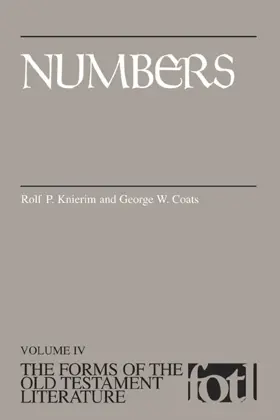

Numbers
in Forms of the Old Testament Literature
Pages
367 pages
Publisher
Eerdmans
Published
2005
ISBN-13
9780802822314
This new commentary on Numbers is not only the latest volume in the respected FOTL series; it is also the first commentary to be written using the exegetical methods of the recently redesigned form-critical approach to the Old Testament literature.
Rolf Knierim and George Coats make clear what has traditionally been a difficult portion of Scripture by showing how form criticism sheds light on the text's structure, genre, setting, and intention. Following an extensive introduction to the historical and social background of Numbers, the commentary proper leads readers unit by unit through the text, highlighting the literary development of Numbers and the meaning that it meant to convey to its audience.
Reviews
George W. Coats and Rolf P. Knierim have done the Forms of the Old Testament Literature volume on Numbers. This is not a commentary but a form-critical study of the book. Many people list this series with commentary lists, so I include it here. I don't find the series very helpful for what most people use commentaries for. This book tends to avoid questions of source criticism to focus on final form structure. They think of the book's primary purpose as a combination of concerns with cultic and military organization, which sets it apart from Leviticus, which reflects none of the military concern. They thus do not see the division between Leviticus and Numbers as arbitrary as many older scholars did. They provide an alternative interpretation of the structure to Olson's view (see above). In some places, they miss big picture structural issues (e.g. the chiastic structure of the rebellion narratives). Reviewers have complained about selective attention to some of the important recent literature on the structure of Numbers. When they do treat source issues, they take a view close to the traditional documentary hypothesis, in the face of much recent work that argues against the traditional assignation of many of these sources. They're often more hesitant to ascribe particular settings to particular passages, however. Coats had written the portion on 10:36 through the end of the book when he stopped work on this book. Knierim wrote the first part, and others were involved in editing Coats's work.
[Full Review]
In the last years the book of Numbers has become a very important field of pentateuchal research. Therefore, each new commentary on this book is awaited with much interest. The commentary of Knierim and Coats, two eminent specialists in matters of the Pentateuch, is mainly devoted to a form-critical reading of the book, in compliance with the design of the FOTL project. The diachronic and redaction problems are not denied, but they do not play a major role in the presentation. In the introduction, the authors deal with the overall structure of Numbers. They recognize that the fourth book of the Torah “does not easily reveal a coherent and homogeneous literary work” (6). Nevertheless, the book in its “final” form should be understood as a “saga of the migratory campaign” with a twofold subdivision: “the legend of the organization of the sanctuary campaign” (1:1–10:10) and “the saga of the campaign itself” (10:11–36:13; in a recent work, Knierim’s student, W. Lee argues for the same division: Won W. Lee, Punishment and Forgiveness in Israel’s Migratory Campaign [Grand Rapids: Eerdmans, 2003]). Knierim and Coats reject Olson’s suggestion that Numbers is organized through the twofold census in Num 1 and 26. This would suggest that the main theme of Numbers is the transition from the old generation to the new (Dennis T.
[Full Review]
Die verdienstvolle Reihe hat es sich zur Aufgabe gestellt, eine begrifflich differenzierte N�herbestimmung der literarischen Formen der alttestamentlichen Literatur zu erarbeiten. Hierzu liefert der vorliegende Band (verfasst von R. P. Knierim zu Num 1�10, G. W. Coats Num 11�36, bearbeitet von M. Jacobs und D. Palmer [Claremont]) einen wertvollen Beitrag, dessen Ertrag u.a. in dem (englisch/deutschen) Glossar der Gattungen und Formeln am Ende des Bandes (337�67) form uliert ist. Es wird die Verst�ndigung �ber die Bezeichnungen von Redeformen vor antreiben. Demgegen�ber bleibt die Behandlung der literarhistorischen Probleme des Buches eigent�mlich hinter der gegenw�rtigen Forschungsdiskussion zur�c k. Gerechnet wird mit einem Jahwist (J), vermutet wird ein Elohist (E), der aber dann in der Untersuchung nicht mehr erscheint, sodann vermutet man einen Redaktor JE, dessen Wirken aber f�r die Rekonstruktion der Makrostrukturen am Ende auch keine Rolle spielt, und schlie�lich gibt es das Cham�leon �Priestly writings�, hinter dem sich die Annahme einer wie immer gearteten Priestergrundschrift mit Erg�nzungen (Pg, Ps ) verbirgt, sowie die einer Reihe von nicht n�her nachweisbaren Corpora priesterlichen Schrifttums, aus denen sich diverse Hinzuf�gungen des Numeribuches er kl�ren lassen.
[Full Review]

